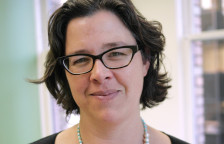Kate Gordon, the Paulson Institute’s vice chair, weighs in on the Pope, recent Paulson Institute energy dialogues and a town called Pinggu that may become a model for China’s new sustainable economic development plans. “Kate’s Cliffnotes,” a regular blogpost originated when Gordon ran the climate and energy program at the think tank Next Generation, has migrated to the Paulson Institute.
 Happy late July! So much for my intention to do a post every 2 weeks – I think I’m at 6 weeks and counting since the last one. It’s not that there’s been a lack of things to write about; in fact it’s exactly the opposite. The past month has been a whirlwind of activity on climate issues, from the Pope’s encyclical calling out climate change as “one of the principal challenges facing humanity in our day,” to 12 countries’ submissions—including major economy/emitter China—of their GHG emission reduction plans to the UN in preparation for the big climate negotiation in Paris; to the California legislature’s continuing effort to push the state’s renewable, efficiency, and clean transportation standards even higher (CalMatters has a nice snapshot of the existing and proposed policies here).
Happy late July! So much for my intention to do a post every 2 weeks – I think I’m at 6 weeks and counting since the last one. It’s not that there’s been a lack of things to write about; in fact it’s exactly the opposite. The past month has been a whirlwind of activity on climate issues, from the Pope’s encyclical calling out climate change as “one of the principal challenges facing humanity in our day,” to 12 countries’ submissions—including major economy/emitter China—of their GHG emission reduction plans to the UN in preparation for the big climate negotiation in Paris; to the California legislature’s continuing effort to push the state’s renewable, efficiency, and clean transportation standards even higher (CalMatters has a nice snapshot of the existing and proposed policies here).
All these paths will magically converge on July 21 (tomorrow!) as California’s Governor Jerry Brown heads to the Vatican to a climate symposium where he’ll push California’s policies as a model for other countries struggling to find local actions that can begin to meet this global challenge.
My own recent travels are nowhere near as exalted, but they’ve been incredibly interesting. Most important was a trip to Beijing in June to meet the Paulson Institute team on the ground there and to participate in two policy roundtables, one on building energy disclosure and the other on emissions trading. These discussions were at once incredibly familiar—it turns out the opportunities and barriers to disclosing building energy use are extremely similar in the US and China, mostly boiling down to the need for a cost structure and policy environment that makes it worth the building owner’s while—and entirely new—in China, disclosure has the additional problem of a general lack of data transparency, which is slightly easier to overcome here in the US (especially if you simply require energy use transparency as a condition of receiving government funds for energy retrofits, as in California’s Proposition 39). The trip reminded me of one of the central truths about working on climate and energy issues: while the problem of global climate change is truly global, its solutions are inherently local, and very specific to each particular regional economy.
Three recent Paulson Institute papers underscore this truth. The first is a high-level scene setter written by our Beijing-based team and focused on the range of air quality and climate issues facing China today. It’s a must-read for anyone who wants an overview of the current government reform efforts and regulations that interact to create a policy environment in China where there’s high-level intent to address pollution issues, but challenges in turning that intent into action at the provincial and local levels. Particularly fascinating to me is the integration at the highest levels in China of economic and environmental strategy, with the clear intent from the central government to find new ways to grow the economy that are also more sustainable than the current model. Again, the challenge is how to translate the intent into local, specific action.
For that, China needs to look at particular regions, such as Pinggu, a small district on the outskirts of Beijing that is looking for a sustainable economic development strategy that takes advantage of its existing assets, and particularly its rural and agricultural land. Pinggu could become a model for how to ensure Chinese cities do not simply sprawl outward, but pursue targeted growth strategies that include growth boundaries and economically-productive rural and preserved land. Our recent Pinggu report, co-authored with RMI and LBNL, outlines just such a strategy for the area.
Finally, out of the PI think tank comes an even more specific case study of sustainable economic growth (and one that will be familiar to California readers): an analysis of China’s investment in the BYD electric bus factory in Lancaster, California. In venturing into the California market, BYD found a policy and cultural environment far different from the one that the company was used to in China. The case study goes into detail on BYD’s experience, ultimately offering “a cautionary tale about the pitfalls and complexities that confront ambitious Chinese investors in the United States.”
The bottom line: we can talk all we want about the macroeconomic case for addressing climate change, but the real work will always happen at a far more granular level: through provincial or state legislatures, through city planning, through business development strategy. Our central challenge is to keep a thread running through all these strategies that ties them back to the key question: how to find a model for economic development in the 21st century that’s truly sustainable.
With that, I’ll sign off with my new Chinese name, which apparently means “dark green fortress”. I’ll be retreating into that fortress to cook up a new post. More soon!
成可黛


